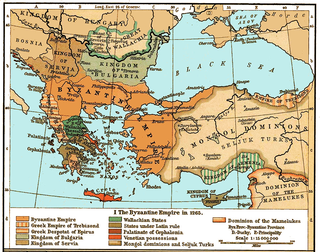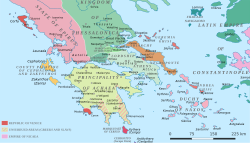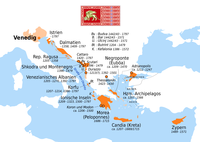
Evia also known by its antique spelling Euboea is the second-largest Greek island in area and population, after Crete, and the sixth largest island in the Mediterranean Sea. It is separated from Boeotia in mainland Greece by the narrow Euripus Strait. In general outline it is a long and narrow island; it is about 180 km (110 mi) long, and varies in breadth from 50 km (31 mi) to 6 km (3.7 mi). Its geographic orientation is from northwest to southeast, and it is traversed throughout its length by a mountain range, which forms part of the chain that bounds Thessaly on the east, and is continued south of Euboia in the lofty islands of Andros, Tinos and Mykonos.

William of Villehardouin was the fourth prince of Achaea in Frankish Greece, from 1246 to 1278. The younger son of Prince Geoffrey I, he held the Barony of Kalamata in fief during the reign of his elder brother Geoffrey II. William ruled Achaea as regent for his brother during Geoffrey's military campaigns against the Greeks of Nicaea, who were the principal enemies of his overlord, the Latin Emperor of Constantinople Baldwin II. William succeeded his childless brother in the summer of 1246. Conflicts between Nicaea and Epirus enabled him to complete the conquest of the Morea in about three years. He captured Monemvasia and built three new fortresses, forcing two previously autonomous tribes, the Tzakones and Melingoi, into submission. He participated in the unsuccessful Egyptian crusade of Louis IX of France, who rewarded him with the right to issue currency in the style of French royal coins.

Karystos or Carystus is a small coastal town on the Greek island of Euboea. It has about 5,000 inhabitants. It lies 129 km south of Chalkis. From Athens it is accessible by ferry via Marmari from the port of Rafina. After the Greek war of independence, its urban plan was laid out by the renowned Bavarian civil engineer Bierbach, in the middle of the 19th century.
A sestiere is a subdivision of certain Italian towns and cities. The word is from sesto (‘sixth’), so it is thus used only for towns divided into six districts. The best-known example is the sestieri of Venice, but Ascoli Piceno, Genoa, Milan and Rapallo, for example, were also divided into sestieri. The medieval Lordship of Negroponte, on the island of Euboea, was also at times divided into six districts, each with a separate ruler, through the arbitration of Venice, which were known as sestieri. The island of Crete, a Venetian colony from the Fourth Crusade, was also divided into six parts, named after the sestieri of Venice herself, while the capital Candia retained the status of a comune of Venice. The island of Burano north of Venice is also subdivided into sestieri.

The War of the Euboeote Succession was fought in 1256–1258 between the Prince of Achaea, William of Villehardouin, and a broad coalition of other rulers from throughout Frankish Greece who felt threatened by William's aspirations. The war was sparked by Villehardouin's intervention in a succession dispute over the northern third of the island of Euboea, which was resisted by the local Lombard barons with the aid of the Republic of Venice. The Lord of Athens and Thebes, Guy I de la Roche, also entered the war against William, along with other barons of Central Greece. Their defeat at the Battle of Karydi in May/June 1258 effectively brought the war to an end in an Achaean victory, although a definite peace treaty was not concluded until 1262.
Oberto, Uberto, or Umberto II was the Count of Biandrate (Blan-Dras) in Lombardy and a participant in the Fourth Crusade.
Licario, called Ikarios by the Greek chroniclers, was a Byzantine admiral of Italian origin in the 13th century. At odds with the Latin barons of his native Euboea, he entered the service of the Byzantine emperor Michael VIII Palaiologos, and reconquered many of the Aegean islands for him in the 1270s. For his exploits, he was rewarded with Euboea as a fief and rose to the rank of megas konostaulos and megas doux, the first foreigner to do so.

Boniface of Verona was a Lombard Crusader lord in Frankish Greece during the late 13th and early 14th century. A third son from a junior branch of his family, he sold his castle to equip himself as a knight, became a protégé of Guy II de la Roche, Duke of Athens, expelled the Byzantines from Euboea in 1296, and advanced to become one of the most powerful lords of Frankish Greece. Following Guy II's death, he served as regent for the Duchy of Athens in 1308–09, and was captured by the Catalan Company in the Battle of Halmyros in March 1311. The Catalans held Boniface in high regard, and offered to make him their leader. Boniface refused, but retained close relations with them, sharing their hostility towards the Republic of Venice and its own interests in Euboea. Boniface died in late 1317 or early 1318, leaving his son-in-law, the Catalan vicar-general Alfonso Fadrique, as the heir of his domains.
Ravano dalle Carceri was a Lombard nobleman. He was one of the first triarchs of Negroponte from 1205.
Maria Sanudo was lady of the island of Andros in the Duchy of the Archipelago in 1372–1383, and lady of the island of Paros and of one third of Negroponte in 1383–1426 in co-regency with her spouse, Gaspare Sommaripa.

The Battle of Demetrias was a sea engagement fought at Volos in Greece in the early 1270s between a Byzantine fleet and the assembled forces of the Latin barons of Euboea (Negroponte) and Crete. The battle was fierce, and initially in favour of the Latins, but the timely arrival of Byzantine reinforcements tipped the scale, resulting in a crushing Byzantine victory.
Guglielmo II da Verona was a Lombard noble from the triarchy of Negroponte (Euboea), considered by earlier historians as a triarch and a marshal of the principality of Achaea in Frankish Greece.
Bartholomew II Ghisi was a Latin feudal lord in medieval Greece, lord of Tinos and Mykonos, Triarch of Negroponte and Grand Constable of the Principality of Achaea.
James II of Avesnes was a knight of the Fourth Crusade. He was probably the son of James of Avesnes of Hainaut, who was a leading protagonist of the Third Crusade.
Peter dalle Carceri was a Triarch of Euboea and Baron of Arcadia. He was descended from the noble Dalle Carceri family, son of Grapozzo dalle Carceri and Beatrice of Verona, both Lords of Euboea.
The Family of Verona was a noble Italian family originally from Verona. The family descended from the Lombards, and are most notable as the ruling house of the Triarchy of Negroponte, established on the island of Euboea in Greece, between 1205 and 1470.
The First Parliament of Ravennika was convened in May 1209 by Latin Emperor Henry of Flanders in the town of Ravennika in Central Greece in an attempt to resolve the rebellion of the Lombard barons of the Kingdom of Thessalonica.

The House of Ghisi was a prominent Venetian noble family, originally from Padua or Aquileia.

The dalle Carceri were a noble family of Verona and Frankish Negroponte from the 12th to the 14th century.
Carintana dalle Carceri was the triarch of the northern third (Oreus) of the Lordship of Negroponte in Frankish Greece in circa 1220–1255.
















